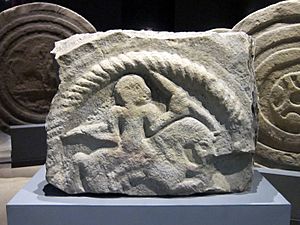Cantabrian circle facts for kids

The Cantabrian circle (in Latin: circulus cantabricus) was a clever battle trick. It was created in ancient Spain. This tactic was used by light cavalry (soldiers on horseback). These horsemen were armed with javelins (small spears) or bows. The Cantabri tribes often used this tactic. Later, Rome adopted it after the Cantabrian Wars.
How Did the Cantabrian Circle Work?
A group of horsemen, armed with javelins or bows, would ride in a big circle. They rode in a single line, one after another. As each rider came close to the enemy, they would throw a javelin or shoot an arrow. This created a constant rain of weapons on the enemy.
This trick was mostly used against infantry (soldiers fighting on foot). This included archers, arbelists (crossbow users), peltasts (light infantry), and slingers. The horsemen were always moving. This made them hard for the enemy to hit. It also gave them an advantage over slower foot soldiers.
The main goals of this move were to bother the enemy and break up their formations. It often made the enemy charge forward too early or in a messy way. This tactic was very useful against slow, heavily armored soldiers. A good example is the powerful legions of the late Roman Republic and early Roman Empire.
The Cantabrian circle was great because the riders did not need to make a perfect circle. They could keep a safe distance from the enemy. The slower foot soldiers had little chance of catching the fast cavalry. This put the infantry at a big disadvantage.
The Cantabrian circle is similar to other cavalry moves. These include the caracole and the Parthian shot.
See also
- In Spanish: Cantabrian Circle for Kids

